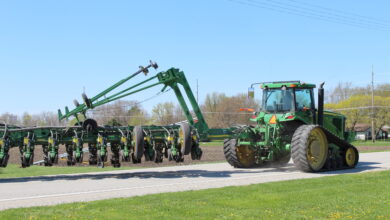Sunday Talk: Grassley on How Congress Can Lend Farmers a Helping Hand

We celebrated this National Agriculture Week on the heels of a new industry census, which the U.S. Department of Agriculture (USDA) issues every five years. The report spotlights short-term trends, with USDA’s latest survey covering 2017 through 2022. It also contextualizes long-term themes: How does today’s farm landscape measure against those of decades’ past? This year’s census data offered a window into an ever-widening gap – one an Iowa State University economist dubbed “the disappearing middle.”
Iowa’s family farmers, regardless of how much land they own, all proudly put in the work to carry on our state’s agricultural tradition. The USDA sorts these farms by size to get a thorough look at what’s happening in agriculture. In terms of acreage, the smallest farms are those under 180 acres; the largest farms are over 2,000 acres; and mid-sized farms are those in between. From 2002 to 2022, the number of large farms in Iowa increased by roughly 77 percent and small farms, by just over 10 percent. Within that same period, nearly one in four of Iowa’s mid-sized farms ceased operating. And while Iowa may have boasted a slight boost in its total number of farms since 2017, USDA has long reported a nationwide decline. When barn doors close and tractor engines shut off for good, it impacts school enrollment, economic vitality and community engagement.
As of yesterday, the corn bid at the co-op near the Grassley farm in New Hartford was valued at $4.37 per bushel. As a lifelong farmer, I know margins are thin for commodities like corn, soybeans, pork and poultry products. Without a doubt, drought conditions across Iowa continue to impact yields. Congress can and should do what it can to assist farmers as they navigate unpredictable hands dealt by Mother Nature and the markets. After all, farmers make up two percent of our population, yet they feed themselves and the other 98 percent of the nation – not to mention the other countries reliant on U.S. exports. Myriad bills on the federal policymaking tables could help bring farmers certainty, preserve generational farms and reduce barriers to entry for young and emerging producers. It’s time Congress exercise some Midwest commonsense and get those measures across the finish line.
Farmers may be opting to scale back, shut down or sell off due to high input costs exacerbated by inflation. Last growing season, producers set aside over 30 percent of their input expenditures for fertilizer. That’s why I’m leading bipartisan legislation to direct a study on fertilizer cost determinants, including potential consolidation in the sector. Farmers ought to have as much price transparency as possible when they balance their books. Congress needs this information to understand what’s driving steep fluctuations in fertilizer prices. Smart trade partnerships with fertilizer-supplying nations may ease costs, too.
Creating opportunities for Iowa farmers of all sizes means strengthening export prospects. Internationally, the projected trade deficit for U.S. agriculture products jumped to $30.5 billion this year. State laws are shrinking markets, as well. California’s Proposition 12 took effect in January, banning the sale of certain pork depending on how the pig was raised. The Massachusetts legislature is finalizing a similarly counterproductive policy. It’s Congress’ responsibility to regulate interstate commerce, so I’m co-leading a bill to do exactly that. Coastal states shouldn’t be able to tell Iowa hog farmers how to do their jobs. I’ll keep working to advance our legislation, but the ball is largely in Democrats’ court. They should either agree to wrap the EATS Act into the farm bill, or the Democrat Senate Majority Leader should move the bill through the legislative process.
Finally, let’s not forget market expansion extends to biofuels. Whether it be encouraging consensus on the science-based GREET Model – which, if adopted broadly, would enable ethanol producers to supply fuel for commercial aviation – or permitting year-round, nationwide E-15 sales, there are surefire ways the federal government can cut red tape to unleash the powerhouse that is Iowa ag.
During National Agriculture Week, it’s been heartening to witness our producers receive the recognition they deserve all year-round. Congress ought to sustain this spirit of appreciation as it continues to tackle issues facing American agriculture. In addition to the initiatives I’ve outlined, this will mean putting more farm in the farm bill, increasing reference prices and passing a five-year reauthorization to promote greater certainty. It will mean protecting mid-sized farms from tax burdens and beefing up competition in industries susceptible to consolidation. And, in lock step with several efforts of mine, it will mean keeping the pedal to the metal to prevent adversaries like China from buying up U.S. farmland. Congress can sow the seeds to encourage ag opportunities, fight consolidation and help family farmers and rural communities thrive.
Grassley also discussed the negotiations regarding the 2024 Farm Bill.




